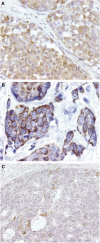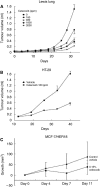Potential use of COX-2-aromatase inhibitor combinations in breast cancer
- PMID: 16100520
- PMCID: PMC2361689
- DOI: 10.1038/sj.bjc.6602690
Potential use of COX-2-aromatase inhibitor combinations in breast cancer
Abstract
Cyclooxygenase-2 (COX-2) is overexpressed in several epithelial tumours, including breast cancer. Cyclooxygenase-2-positive tumours tend to be larger, higher grade, node-positive and HER-2/neu-positive. High COX-2 expression is associated with poor prognosis. Cyclooxygenase-2 inhibition reduces the incidence of tumours in animal models, inhibits the development of invasive cancer in colorectal cancer and reduces the frequency of polyps in familial adenomatous polyposis (FAP). These effects may be as a result of increased apoptosis, reduced angiogenesis and/or proliferation. Studies of COX-2 inhibitors in breast cancer are underway both alone and in combination with other agents. There is evidence to suggest that combining COX-2 inhibitors with aromatase inhibitors, growth factor receptor blockers, or chemo- or radiotherapy may be particularly effective. Preliminary results from combination therapy with celecoxib and exemestane in postmenopausal women with advanced breast cancer showed that the combination increased the time to recurrence. Up to 80% of ductal carcinomas in situ (DCISs) express COX-2, therefore COX-2 inhibition may be of particular use in this situation. Cyclooxygenase-2 expression correlates strongly with expression of HER-2/neu. As aromatase inhibitors appear particularly effective in patients with HER-2/neu-positive tumours, the combination of aromatase inhibitors and COX-2 inhibitors may be particularly useful in both DCIS and invasive cancer.
Figures



References
-
- Altorki NK, Keresztes RS, Port JL, Libby DM, Korst RJ, Flieder DB, Ferrara CA, Yankelevitz DF, Subbaramaiah K, Pasmantier MW, Dannenberg AJ (2003) Celecoxib, a selective cyclo-oxygenase-2 inhibitor, enhances the response to preoperative paclitaxel and carboplatin in early-stage non-small-cell lung cancer. J Clin Oncol 21: 2645–2650 - PubMed
-
- Asano TK, McLeod RS (2004) Nonsteroidal anti-inflammatory drugs and aspirin for the prevention of colorectal adenomas and cancer: a systematic review. Dis Colon Rectum 47: 665–673 - PubMed
-
- Barnes NLP, Warnberg F, White D, Anderson E, Bundred NJ (2003) Cyclooxygenase-2 inhibition and tumour growth: celecoxib increases apoptosis in HER2 positive cell lines. Breast Cancer Res Treat 82(suppl 1) (Abstract 667)
-
- Baum M, Buzdar A, Cuzick J, Forbes J, Houghton J, Howell A, Sahmoud T, The ATAC (Arimidex, Tamoxifen Alone or in Combination) Trialists’ Group (2003) Anastrozole alone or in combination with tamoxifen vs tamoxifen alone for adjuvant treatment of postmenopausal women with early-stage breast cancer: results of the ATAC (Arimidex, Tamoxifen Alone or in Combination) trial efficacy and safety update analyses. Cancer 98: 1802–1810 - PubMed
-
- Benoit V, Relic B, Leval Xd X, Chariot A, Merville MP, Bours V (2004) Regulation of HER-2 oncogene expression by cyclooxygenase-2 and prostaglandin E2. Oncogene 23: 1631–1635 - PubMed
Publication types
MeSH terms
Substances
LinkOut - more resources
Full Text Sources
Medical
Research Materials
Miscellaneous

